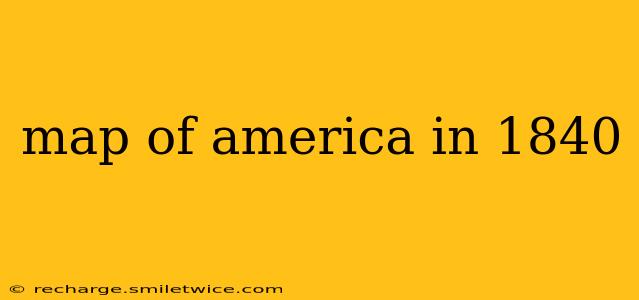The year 1840 marked a pivotal moment in American history. Westward expansion was accelerating, the industrial revolution was taking hold, and the nation was grappling with the ever-present shadow of slavery. Understanding this era requires exploring its cartographic representation – a map of America in 1840 offers a fascinating glimpse into a nation on the cusp of significant change. While a single, definitive map doesn't exist, piecing together various resources provides a compelling picture.
What Did a Map of America in 1840 Show?
Maps from 1840 generally depicted the United States as it existed after the admission of Arkansas and Michigan as states in 1836. The boundaries were largely defined, though the precise demarcation of western territories remained fluid due to ongoing exploration and treaties with Native American nations. These maps would visually represent:
-
The 26 States: The established states would be clearly marked, showcasing their growing populations and expanding infrastructure. The relative size and location of each state provided an immediate visual representation of the nation's geographic scope.
-
Territories: Vast territories like Wisconsin, Iowa, and Florida (still in the process of statehood) would be present, often colored differently to distinguish them from states. These areas were largely undeveloped, with sparse settlements and significant portions unexplored.
-
Major Cities and Towns: Important population centers like New York, Philadelphia, Boston, New Orleans, and Charleston would be prominent features, indicating the burgeoning urban growth that was occurring along the East Coast and in key river ports.
-
Rivers and Waterways: The Mississippi River and its tributaries played a crucial role in trade and transportation, and thus were depicted prominently, showcasing their importance to the nation's economy. Other major rivers and navigable waterways were similarly emphasized.
-
Mountains and Key Geographic Features: Major mountain ranges like the Appalachians were included, providing a sense of the country's varied topography. Other prominent landmarks, essential for navigation and settlement, were also present.
-
Limited Detail in the West: The western territories, especially beyond the Mississippi, would be shown with less detail due to the limited exploration and mapping that had been undertaken at the time. Much of the West remained mysterious and largely uncharted.
What were the limitations of maps from 1840?
It's crucial to acknowledge the limitations of these early maps:
-
Inaccurate Boundaries: The precise boundaries of territories and even some states might not be entirely accurate due to ongoing surveying and disputes.
-
Lack of Detail in the West: As mentioned, the western territories lacked the detailed cartography found in the more settled eastern regions.
-
Indigenous Populations: While the presence of Native American nations was sometimes acknowledged, it was often limited and lacked the nuanced representation of their territories and sovereignties that is crucial for a modern understanding.
How did maps of America in 1840 reflect the era's significant events?
The maps of this period indirectly reflected several key events shaping the United States:
-
Westward Expansion: The inclusion of territories and the emphasis on rivers like the Mississippi highlighted the accelerating westward movement of settlers and the burgeoning ambition to expand the nation's reach.
-
The Trail of Tears: While not explicitly depicted on most maps, the forced relocation of Native American tribes was a significant event that impacted the landscape and profoundly altered the demographic distribution of the nation, a history which the maps inadequately reflect.
-
Technological Advancements: The increasing accuracy and detail of some maps reflect improvements in surveying techniques and cartographic practices of the time.
Where can I find a map of America in 1840?
While finding a single, readily available digital map of the US from 1840 might be challenging, resources like the Library of Congress and various historical societies hold extensive archives of maps from this era. Searching their online catalogs for "maps of the United States 1840" or similar terms will yield promising results. Many university libraries also hold valuable historical map collections. Remember that these maps will be in various formats and often require some level of historical context to understand fully.
By exploring these historical maps, we gain a richer understanding of America’s transformation in 1840. They offer a valuable lens through which to view the nation's expansion, its nascent industrialization, and the complex political and social forces that shaped its destiny. Examining these historical artifacts provides a more complete picture of the past and encourages critical reflection on how representation and mapping shape our understanding of history.
